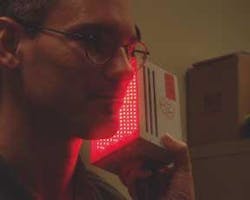Shining near-infrared (NIR) radiation on damaged retinal cells can keep the cells alive and prevent permanent blindness in people whose eyes have been damaged by lasers, according to research funded by the U.S. Defense Advance Research Projects Agency (DARPA). The technique of using one kind of light to heal eyes damaged by another kind of light could be used to treat a wide range of eye injuries and diseases.
The research was prompted by a need for a technique to promote rapid healing of combat injuries, especially when the injured party must be self-sufficient. The objective was for nonmedical personnel to be able to carry lightweight, rapidly effective equipment in combat. The National Aeronautics and Space Administration (NASA) hoped it could use the technique to treat astronauts in space, where injuries heal more slowly than on Earth, possibly because mitochondria do not function properly.
The treatment requires high-intensity light, but instead of lasers, NASA has developed powerful light-emitting diodes (LEDs) for the job. Lasers tend to damage cells, whereas LEDs can deliver light in a way that is less harmful to tissue, according to researchers. "Light-emitting diodes are better than lasers for this purpose because they can treat all of the tissue equally, rather than only at one point of light," explains Harry Whelan, a professor of neurology at the Medical College of Wisconsin (Milwaukee, WI).
Whelan and his colleagues blinded rats by giving them high doses of methanol (wood alcohol). The body converts methanol into formic acid, a toxic chemical that inhibits the activity of mitochondria. Within hours, the rats' energy-hungry retinal cells and optic nerves began to die, and the animals went completely blind within one to two days. At 5, 25, and 50 h after being dosed, the rats were treated with LED light at 670 nm for 105 s. Following the treatment, the rats recovered 95% of their sight. With less than 2 min of treatments, the function of the retinas of small animals was restored after the animals were completely blind.
"Remarkably, the retinas of these rats looked indistinguishable from those of normal rats," says Whelan. "There was some tissue regeneration, and neurons, axons, and dendrites may also be reconnecting." The results have raised the hope that the LED technique could be used to treat eye diseases such as diabetic retinopathy and macular degeneration, known to be caused by mitochondrial problems. Whelan also thinks it will help treat laser injuries to the retina, when cells have not been completely destroyed.
Stimulating mitochondria
Other studies have shown that NIR wavelengths can boost the activity of mitochondria. While it is not yet clear how the light stimulates healing, Britton Chance of the University of Pennsylvania has shown that about 50% of the NIR light is absorbed by mitochondrial proteins called chromophores. Whelan and his colleagues think the light boosts the activity of a chromophore called cytochrome c oxidase, a key component of the energy-generating machinery.
Infrared light is already being used to treat severe mouth ulcers in children undergoing chemotherapy. Whelan has tested the LEDs on 30 children suffering from mucositis, a painful side-effect of cancer chemotherapy. The LED treatment eliminated the mucositis and is now being used to prevent it. The FDA has approved further clinical trials of this treatment. Using funding from the NASA Small Business Innovative Research program, Quantum Devices (Barneveld, WI) is developing light sources that can aid in wound healing as well as light sources that help treat cancer.
"We expect to use the method on a host of other injuries, including musculoskeletal and internal injuries, as well as trauma and burns," Whelan adds. "As we adjust the LED parameters, we can alter the different genetic messages, depending on what kind of tissue we're trying to treat."
